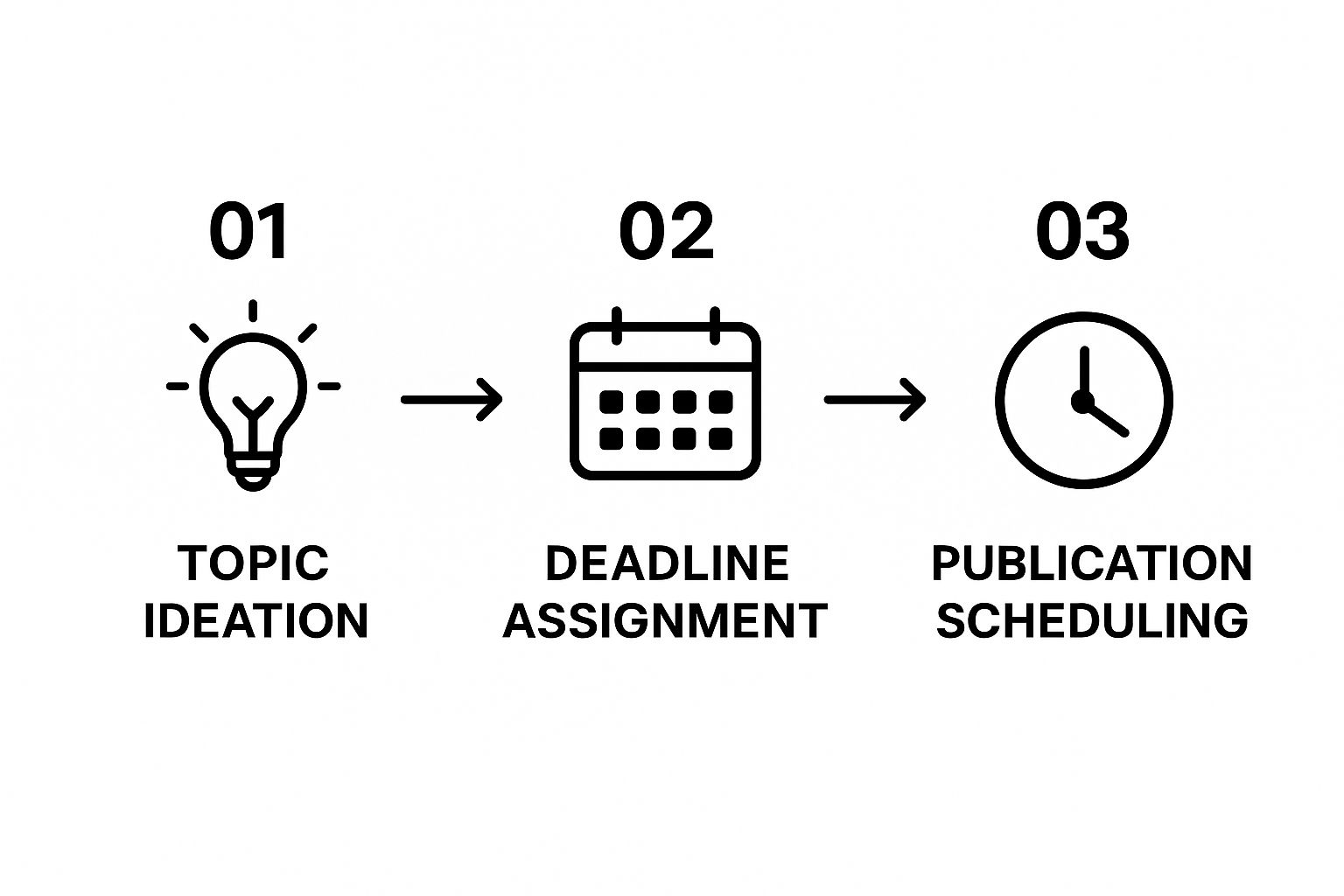The Evolution of Effective Content Marketing Workflow

The content marketing world has changed significantly. Simple editorial calendars are no longer enough. Today’s successful content strategies depend on flexible and connected content marketing workflows. This shift reflects the growing realization that effective content isn’t simply about creation. It’s about a strategic process, from initial idea to final analysis.
From Calendars to Comprehensive Systems
Traditional editorial calendars mainly focused on scheduling. Modern content marketing workflows, however, cover much more. They include every step of the content lifecycle:
- Strategy: Defining your target audience, setting clear goals, and choosing key performance indicators (KPIs).
- Ideation: Coming up with and refining content ideas based on data and audience insights.
- Creation: Developing high-quality content in a variety of formats, including blog posts, videos, and infographics.
- Distribution: Sharing content across different channels to connect with your target audience.
- Analysis: Measuring content performance and using data to improve future content.
This complete approach ensures content is created efficiently and contributes to measurable business results. For a deeper dive into effective content strategies, explore this helpful resource on content marketing workflow.
The Impact of AI
Technological advances have greatly influenced content marketing workflows. The use of Artificial intelligence (AI) is changing content creation. Currently, it’s the primary application of AI in marketing, making up 35% of usage. AI improves automation, personalization, and data analysis, leading to more streamlined workflows and better content. 86% of marketers report saving at least an hour on creative tasks with AI, and 46% use it for writing marketing copy. AI has also boosted content marketing ROI for 68% of companies. Learn more about the impact of AI on content marketing here. This integration indicates a move toward smarter, data-driven content strategies.
The Importance of Optimization
Optimizing your content marketing workflow is essential. A well-defined workflow improves team collaboration, removes obstacles, elevates content quality, and ultimately, drives better results. It makes sure all team members are on the same page, processes run smoothly, and resources are used wisely. As AI continues to develop, it will play an even bigger role in optimizing workflows, increasing audience engagement, and achieving consistent growth. The key is to find a balance between creative freedom and structured processes, encouraging innovation while maintaining efficiency and consistency.
Building Your Content Marketing Workflow Blueprint
Creating a truly effective content marketing workflow isn’t just about checking off tasks; it’s about crafting a strategic blueprint. This involves aligning your workflow with your overarching business goals and deeply understanding your target audience. Think of it like conducting an orchestra: each instrument (team member, task, tool) plays a crucial role in creating a harmonious symphony (successful content).
Content Audit and Audience Research
Before building your workflow, perform a content audit to identify content gaps. This helps pinpoint what’s working, what’s not, and where opportunities exist. Simultaneously, conduct audience research to understand your audience’s needs and preferences. This data-driven approach informs smarter content decisions and ensures you address the complete customer journey. For example, if your audit reveals a lack of video content, and your research indicates audience preference for video tutorials, prioritize video creation within your workflow.
Mapping the Content Journey
Content mapping organizes content to align with the buyer’s journey stages. This could involve creating different content formats for each stage: blog posts for awareness, case studies for consideration, and product demos for the decision stage. Mapping helps visualize the entire customer journey, ensuring each piece of content serves a specific purpose. This is crucial, as a disjointed content experience can lead to confusion and missed opportunities. The infographic below visualizes a simplified content marketing workflow.

This infographic highlights the sequential steps of a basic content workflow, from ideation and deadlines to publication. A well-defined process, even a simple one, ensures consistent content delivery. However, the effectiveness of your strategy matters significantly. Only 29% of marketers with a documented content marketing strategy find it extremely or very effective, while 58% rate it as moderately effective. Common challenges include unclear goals and a disconnect from the customer journey. Find more detailed statistics from the Content Marketing Institute. This underscores the need for a robust, audience-focused workflow.
To further illustrate how to build an effective workflow, let’s look at the key components:
To further illustrate the components of a robust content workflow, the following table provides a detailed breakdown:
Components of an Effective Content Marketing Workflow
A breakdown of the essential stages in a content marketing workflow with key activities for each phase.
| Workflow Stage | Key Activities | Tools/Resources Needed | Common Challenges |
|---|---|---|---|
| Strategy & Planning | Define target audience, set goals, conduct keyword research, develop a content calendar | SEMrush, Ahrefs, Google Analytics, spreadsheets | Lack of clear goals, difficulty prioritizing content |
| Content Creation | Write blog posts, create videos, design infographics, develop ebooks | Grammarly, Canva, video editing software | Writer’s block, maintaining content quality, meeting deadlines |
| Content Optimization | Optimize content for SEO, ensure readability, add visuals | SEO plugins, image optimization tools | Keyword stuffing, poor readability, lack of engaging visuals |
| Content Promotion & Distribution | Share content on social media, email marketing, paid advertising | Social media management tools, email marketing platforms | Low engagement, reaching the target audience, budget constraints |
| Content Analysis & Reporting | Track website traffic, measure conversions, analyze social media engagement | Google Analytics, social media analytics tools | Difficulty interpreting data, proving ROI, adjusting strategy based on insights |
This table provides a practical overview of the various stages involved in a content marketing workflow, along with the necessary activities, tools, and challenges associated with each stage. By understanding these elements, you can create a more efficient and impactful content strategy.
Establishing Roles and Responsibilities
Clearly defined roles and responsibilities are essential. Each team member should understand their individual contributions and how they fit into the larger content creation process. This involves assigning ownership of different tasks, like writing, editing, SEO optimization, and content distribution. This not only improves accountability but also empowers team members to specialize and excel.
Approval Processes and Governance
Efficient approval processes are essential for maintaining content quality and avoiding bottlenecks. Establish a clear chain of command and timelines for reviews and approvals. Content governance ensures consistency across platforms by establishing style guides, brand guidelines, and messaging frameworks. This maintains a unified brand voice and prevents conflicting information from reaching your audience, ultimately contributing to a streamlined content operation that consistently produces high-quality output.
The Strategic Content Tech Stack: Tools That Transform

Building a successful content marketing workflow hinges on selecting the right tools. It’s not about adopting every new software, but strategically choosing technologies that enhance your specific processes. Think about how each step in your content lifecycle integrates, as discussed in this helpful guide about content creation workflow. This integration is key to avoiding tool overload and maximizing efficiency.
Project Management Platforms: Enhancing Collaboration
Effective collaboration is fundamental to a smooth content marketing workflow. Project management platforms centralize communication, task assignments, and progress tracking. Tools like Asana, Trello, or Monday.com facilitate team communication, ensuring everyone stays on the same page. These platforms also offer helpful visualization features like Kanban boards and Gantt charts for managing project complexity.
Content Creation Tools: Boosting Productivity
Specialized tools can significantly improve the content creation phase. Grammarly enhances writing quality and consistency, while Canva empowers teams to create engaging visuals, regardless of design expertise. For video content, tools like Movavi provide intuitive editing features. Leveraging these tools allows content teams to boost output without sacrificing quality. For example, studies show that 86% of marketers using AI for content creation report saving at least one hour on creative tasks.
Publishing Systems: Saving Time and Effort
Efficient publishing is crucial for timely content delivery. Content Management Systems (CMS) like WordPress or HubSpot simplify website updates and blog posting. Mailchimp automates email campaign delivery. These systems streamline publishing, saving valuable time and maintaining consistent brand messaging. This is especially important in the fast-paced content marketing world, where timing is key to capturing audience attention.
Analytics Solutions: Gaining Actionable Insights
Data-driven decisions are essential for optimizing your content marketing workflow. Google Analytics provides in-depth website traffic analysis, identifying high-performing content and areas for improvement. Social media analytics platforms track audience engagement, offering insights into audience preferences. Analyzing this data allows you to refine your workflow, making informed adjustments to content strategy, distribution channels, and overall process. This iterative process ensures continuous improvement and maximizes the impact of your content marketing efforts.
Content Production Workflows That Actually Deliver
Creating high-quality content consistently can be a major challenge for many organizations. Bottlenecks appear, teams get frustrated, and content quality suffers. However, by examining successful content operations, we can discover strategies to improve production and elevate quality at the same time. This is why a clearly defined content marketing workflow is so important.
Building a Strong Foundation: Briefs and Guidelines
A crucial element for efficient content creation is a thorough content brief template. A well-crafted brief gives writers and designers clear direction, reducing revisions and ensuring the content aligns with the overall strategy. Think of it as the architect’s blueprint for a building: it lays out all the necessary specifications from the start. In addition, establishing editorial guidelines maintains consistency in tone, style, and messaging across all content. This consistency creates a unified brand experience for your audience and saves time during the editing process.
Content Batching for Increased Productivity
Content batching is another valuable technique. By grouping similar tasks, such as writing several blog posts or designing a series of social media graphics at once, you can significantly boost productivity. This focused approach minimizes task switching and allows creators to enter a state of flow, leading to higher quality work produced in less time. For instance, dedicating one day solely to writing and another to editing can prove more efficient than constantly switching between these tasks.
Managing Freelance Contributors
Many businesses utilize freelance contributors, and managing them effectively is essential for a smooth workflow. Set up clear communication channels, provide detailed briefs, and establish realistic deadlines. This minimizes misunderstandings, ensures quality, and helps freelancers seamlessly integrate into your processes. Using a project management platform like Asana can be extremely helpful for tracking progress, sharing feedback, and keeping everyone aligned, especially when working with multiple freelancers on various projects simultaneously.
Overcoming Common Production Obstacles
Even with the best laid plans, challenges will inevitably arise. Approval delays, limited resources, and inconsistent quality are all common hurdles. Successful content teams address these issues proactively. They implement streamlined approval processes, develop resource allocation strategies, and prioritize quality control throughout the entire workflow. This proactive approach prevents minor setbacks from becoming major roadblocks. Interestingly, the financial impact of content marketing is significant. Content marketing generates three times the leads of outbound marketing at a 62% lower cost, demonstrating its effectiveness. Learn more about the power of content marketing here. This efficiency highlights the importance of a well-structured content production workflow. By implementing these strategies, companies can create sustainable content engines that consistently deliver high-quality content, drive business results, and maximize the return on their content marketing investments.
Distribution Workflows That Amplify Content Impact

Creating high-quality content is only half the battle. Without a robust distribution strategy, even the most compelling content can go unnoticed. A well-defined content marketing workflow is essential for reaching the right audience. By studying successful content programs, we can identify effective promotional strategies that significantly boost visibility and engagement.
Channel-Specific Distribution: Optimizing For Each Platform
Every platform has its own unique characteristics and audience. A channel-specific distribution workflow recognizes these differences. For instance, a detailed blog post might thrive on LinkedIn, while a shorter, visually driven version would be better suited for Instagram. Platform-specific workflows allow you to tailor your message and format for maximum impact. This could involve creating multiple versions of your content, adjusting the tone and style, or using platform-specific features like hashtags or stories.
Consider the following table to understand how different distribution channels require different approaches:
To help illustrate the different approaches needed for various platforms, let’s examine the following comparison:
Content Distribution Channel Comparison: Analysis of different content distribution channels with effectiveness metrics and resource requirements.
| Distribution Channel | Audience Reach | Resource Requirements | Average Engagement | Best Content Types |
|---|---|---|---|---|
| Professional network; Industry-specific reach | Moderate (content creation, scheduling tools) | Moderate (comments, shares, likes) | Long-form articles, industry insights, professional updates | |
| Visually-driven; Younger demographic | Moderate to High (visual content creation, engagement monitoring) | High (likes, comments, shares, stories) | Short-form videos, high-quality images, engaging stories | |
| Real-time updates; News and trends | Low (short-form content creation) | Moderate (retweets, likes, replies) | News updates, short-form content, engaging questions | |
| Broad audience; Diverse interests | Moderate (content creation, community management) | Moderate (likes, comments, shares) | Varied content formats, community building posts, targeted ads | |
| Email Marketing | Targeted audience; Direct communication | Moderate (email list building, email marketing software) | High (opens, clicks, conversions) | Newsletters, product updates, promotional offers |
This table summarizes the key differences between popular content distribution channels. Understanding these nuances is crucial for optimizing your content strategy.
Promotional Calendars and Tagging Systems: Maintaining Consistent Presence
Consistency is paramount in content marketing. A promotional calendar helps maintain a regular posting schedule. It provides a structured plan for distributing content across various channels at the best times. A well-designed tagging system, using relevant keywords, improves content discoverability for both your audience and search engines. This system increases long-term visibility and maximizes your content’s reach.
Repurposing Content: Extending Reach and Lifespan
Repurposing content is a highly effective way to extend its reach and lifespan. This involves adapting existing content into different formats. A webinar, for example, could be repurposed into a series of blog posts, social media updates, or even a short ebook. This not only saves time and resources but also allows you to connect with different segments of your audience.
Team Advocacy and Paid Distribution: Amplifying Organic Reach
Team advocacy can significantly expand your content’s reach. Encouraging team members to share content on their social media channels increases organic reach by tapping into their wider network. This boosts credibility and expands visibility. Paid distribution, such as targeted advertising on platforms like Google or social media, supplements organic efforts. This is particularly valuable for launching new content or reaching a specific demographic.
Case Studies and Improved Results: The Impact of Refined Workflows
Refined distribution workflows have consistently led to better results. Case studies show how organizations have doubled engagement with the same content simply by optimizing distribution processes. These improvements often involve small changes, such as optimizing content for different platforms or establishing a consistent posting schedule, highlighting the significant impact of a well-defined content marketing workflow. These adjustments can greatly improve engagement and amplify your content’s overall impact.
Measuring and Optimizing Your Content Marketing Workflow
Effective content marketing isn’t a set-it-and-forget-it endeavor. It’s a dynamic process that requires constant evaluation and adjustment. Like a gardener tending to their plants, content marketers must regularly prune and adapt their workflows to achieve optimal growth and results. This ongoing evolution is fueled by data insights into content performance and workflow efficiency.
Key Performance Indicators (KPIs): Measuring Content Effectiveness
The foundation of any successful content marketing strategy lies in identifying the right Key Performance Indicators (KPIs). These metrics should directly align with your overarching content marketing goals and business objectives.
For example, if your goal is to increase brand awareness, you might prioritize metrics like website traffic, social media reach, and share counts. However, if lead generation is your primary focus, KPIs such as conversion rates, email sign-ups, and demo requests become more relevant. This targeted approach ensures you’re measuring what truly matters to your business.
Workflow Audits: Identifying Bottlenecks
Regular workflow audits are crucial for uncovering and addressing bottlenecks in your content creation process. These audits involve systematically reviewing each step, from ideation and writing to editing, publishing, and promotion.
Look for areas where delays or inefficiencies occur. For example, lengthy approval processes can significantly slow down content production. Similarly, unclear roles and responsibilities can lead to confusion and duplicated effort. These audits can be conducted through team meetings, surveys, or by analyzing data from workflow management software.
Gathering Team Feedback: Driving Meaningful Change
Gathering feedback from your content team is essential for identifying areas for improvement. Go beyond surface-level critiques and delve into the on-the-ground realities of the workflow. Are there tools that are hindering productivity? Are there communication breakdowns causing delays? Honest and constructive feedback provides valuable insights that can drive meaningful changes and boost team morale.
The Optimization Cycle: Continuous Improvement
Implementing a continuous optimization cycle is the key to long-term success. This cycle involves regularly reviewing KPIs, conducting workflow audits, gathering team feedback, and making adjustments based on the data collected. It’s not a one-time fix, but an ongoing process of refinement. Just as software developers release updates to improve performance, content marketers need to continually tweak their workflows to enhance efficiency and effectiveness.
A/B Testing Workflows: Data-Driven Decisions
A/B testing isn’t just for content elements; entire workflows can be tested to determine the most effective approach. This might involve comparing two different approval processes or testing different project management methodologies. Data from these tests provides objective evidence to support workflow adjustments and inform future decisions.
Case Studies: Learning From Success
Examining how leading organizations have optimized their content marketing workflows offers valuable lessons. Case studies often reveal common challenges and effective solutions. For example, some organizations have successfully implemented agile methodologies to accelerate content production, while others have streamlined approval processes using automated tools. These real-world examples provide practical insights you can use to improve your own workflow. Many successful organizations leverage data-driven insights to adapt their content processes, leading to increased team satisfaction, faster production, and improved content outcomes.
Ready to elevate your content marketing strategy and achieve measurable results? ReachLabs.ai is a full-service marketing agency that integrates world-class talent with data-driven insights to deliver tailored digital strategies and creative solutions. Visit ReachLabs.ai today to learn how we can help you transform your content marketing workflow and achieve your business objectives.





